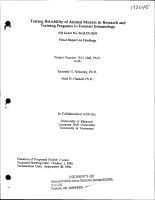Data analysis
Gun Tracing Systems Study Report
Date Published
1976
Agencies
NIJ-Sponsored
Specialized Courtrooms: Does Speeding Up the Process Jeopardize the Quality of Justice?
Date Published
1996
Agencies
NIJ-Sponsored
Estimating Elasticities of Demand for Cocaine and Heroin With Data From the Drug Use Forecasting System
Date Published
1995
Agencies
NIJ-Sponsored
"The Other Way" Program Evaluation
Date Published
March 1999
Agencies
NIJ-Sponsored
Effects of Intimate Partner Violence on Low-Income Women's Health and Employment
Date Published
September 2005
Agencies
NIJ-Sponsored
Anticipating Community Drug Problems
Date Published
February 1992
Agencies
NIJ-Sponsored
Trafficking in Meaning: Law, Victims, and the State
Date Published
March 2011
Agencies
NIJ-Sponsored
Testing Reliability of Animal Models in Research and Training Programs in Forensic Entomology
Date Published
1996
Agencies
NIJ-Sponsored


